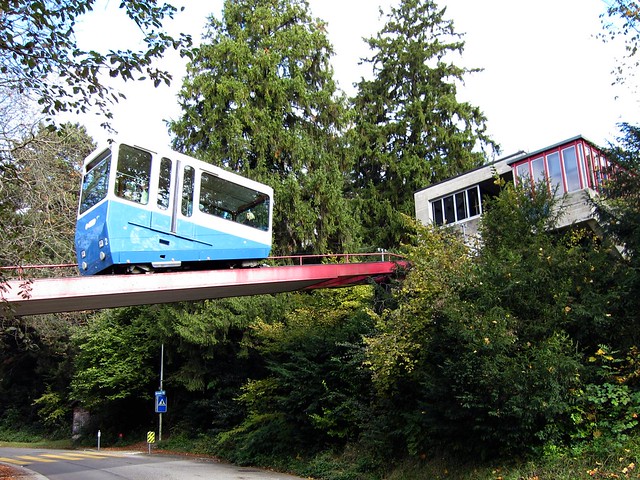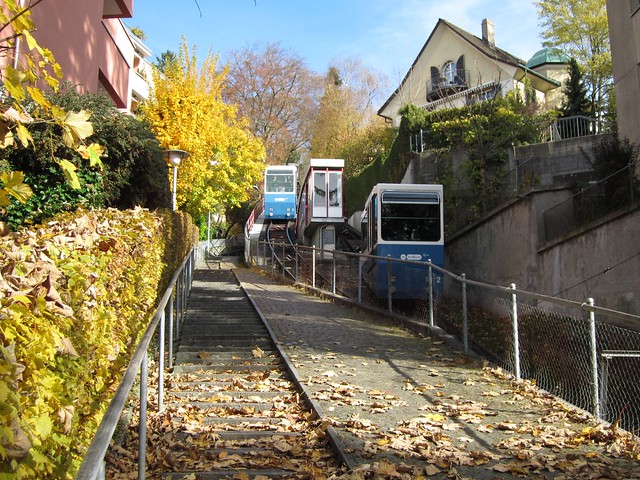This is a guest post by Ross Edgar.
The Swiss city of Zurich has a long heritage with the operation of funicular cable systems. At one time there were three funiculars within the city limits until the Dolderbahn was converted into a rack railway in 1973. Today, two funiculars remain in Zurich: the Polybahn in the city centre (map) and the Rigiblock Funicular (Seilbahn Rigiblick) (map) which climbs the Zurichberg in the north-east of the city.
The Polybahn is an iconic symbol for Zurich, being possibly one of the most well known funicular railways in the world. Since 1889 the Polybahn has carried passengers between Zurich city centre and the main ETH Zurich university building, originally known as Eidgenossisches Polytechnikum. Between its opening in 1889 and its conversion to electric power in 1897, the Polybahn operated as a water balance funicular.
The line has been overhauled on a couple of occasions in its history. In 1976 both the track and the cars were refurbished, but in 1996 a more extensive rebuild was completed with the installation of new track and a new, automated haulage mechanism. Today’s Polybahn is 176m in length and ascends a total of 41m at an average gradient of 23%. The line features the standard funicular layout of two cars and two stations with a single passing loop at the midway point. However, at 955mm the Polybahn’s track gauge is far from standard. Each car has a capacity of 50 people with a travel time of just under two minutes.
The line is significant in its integration within the wider Zurich cityscape. The lower terminus is situated within a row of grand terraced townhouses with the entrance appearing just as any other building in the row. At the opposite end of the building the funicular emerges from the terminus at first storey level, immediately crossing a main road by means of a steel bridge. The Polybahn is a prime example of how a cable system can blend seamlessly and intelligently into a city environment.
The Seilbahn Rigiblick, in contrast, is located in Zurich’s largely residential outer suburbs. The funicular originally opened in 1901 but it was refurbished with all-new cars in the early 1950s and again in the late 1970s, together with an extension of the line at the upper terminus. Today’s Seilbahn Rigiblick is 385m in length and ascends a total of 94m at an average gradient of 25.3%. Interestingly, the line features two cars but a total of five different stops; two termini and three intermediate stops. Each car has a capacity of 30 people with a travel time of two minutes without any intermediate stops.
With its connections to both city tram routes and trolleybus routes, the Seilbahn Rigiblick is a prime example of how cable systems can be integrated within a wider urban transport network. Moreover, while it is not uncommon for funicular systems to feature intermediate stops at the midway point, intermediate stops in addition to this are indeed uncommon. However, as long as the intermediate stops are at uniformed intervals there is no reason why additional intermediate stops could not be a possibility.
Visited or Studied a CPT System? You Can Become a Contributor and Write a Guest Post.
For more information check out the Get Involved page here.






9 Comments
Rigiblick has 5 stations!? that’s incredible.. is it possible to have intermediate stations not placed at uniformed intervals?
It would be possible. It would just result in the opposing car being stopped somewhere on the line rather in a station.
Actually that’s not required either if you put the two cabins on separate cables. Of course that means you need two drive systems, counter-weights for each cabin, very reliable way to make sure both cabins end up at the passing track at the same time. It’s probably doable if you have a good enough reason.
The integration of an additional system is almost always an option to increase capacity/capability. It could therefore be mentioned in just about every article on the Gondola Project. However, as it would represent the doubling of every cost with the exception of the rails it is hardly worth a mention.
Some additional Info
Rigiblick doesn’t run in a suburb but in the city of Zurich itself. Actually in an upper class quarter. The cabins are controlled like an elevator. You have to push a button that the cabin stops at the desired station. The stations are Located symmetrically and the cabins always have to move or stop together.
There was another funicular which is now a rack and pinion railway. It had to be converted to rack and pinion when the line was extended.
There is a Aerial tramway in Adliswil which is a suburb of Zurich.
All those systems are integrated in ZVV. So one ticked is valid for train,tram bus,bot, funicular and aerial tramway.
Zürich airport has a small subway which is a train on air cushions draw by a cable.
Historical note once there was a Aerial tramway crossing Lake Zurich from Wollishofen to Tiefenbrunnen. Later a Gondola on was built in 1959 but unfortunately torn down in 1966 because it was said it spoilt the view. Today such a gondola would be much appreciated but politically impossible to build.
Definition of a suburb: “An outlying district of a city, esp. a residential one.” The term is used to distinguish the location of the Rigiblick from the central commercial district where the Polybahn is located.
Found a very detailed video on the Rigiblick here:
https://www.youtube.com/watch?v=omrNxVf_h9A
Looks like a very nice system, and that middle station is a really elegant design. I like that particularly.
@Ross Edgar. Doppelmayr seems to think this is a god idea on level ground systems. Take a look here:
http://www.dcc.at/doppelmayr/solutions/en/tmp_1_847739867/Configurations_detail.aspx
You’ll note they offer both ‘Double Shuttle’ and ‘Bypass’ systems, which have essentially the same features except for independent operation. In face they are the reason I mentioned it. It’s been done, just not on an inclined system.
That is true. The Toronto Pearson International Airport LINK Train and the Birmingham International Airport AirRail Link are both examples of Cable Liners with two independent systems. In fact I have just finished writing an article on the latter of these two systems. Granted it’s not impossible or even improbable but there would have to be real advantage in terms of flexibility.